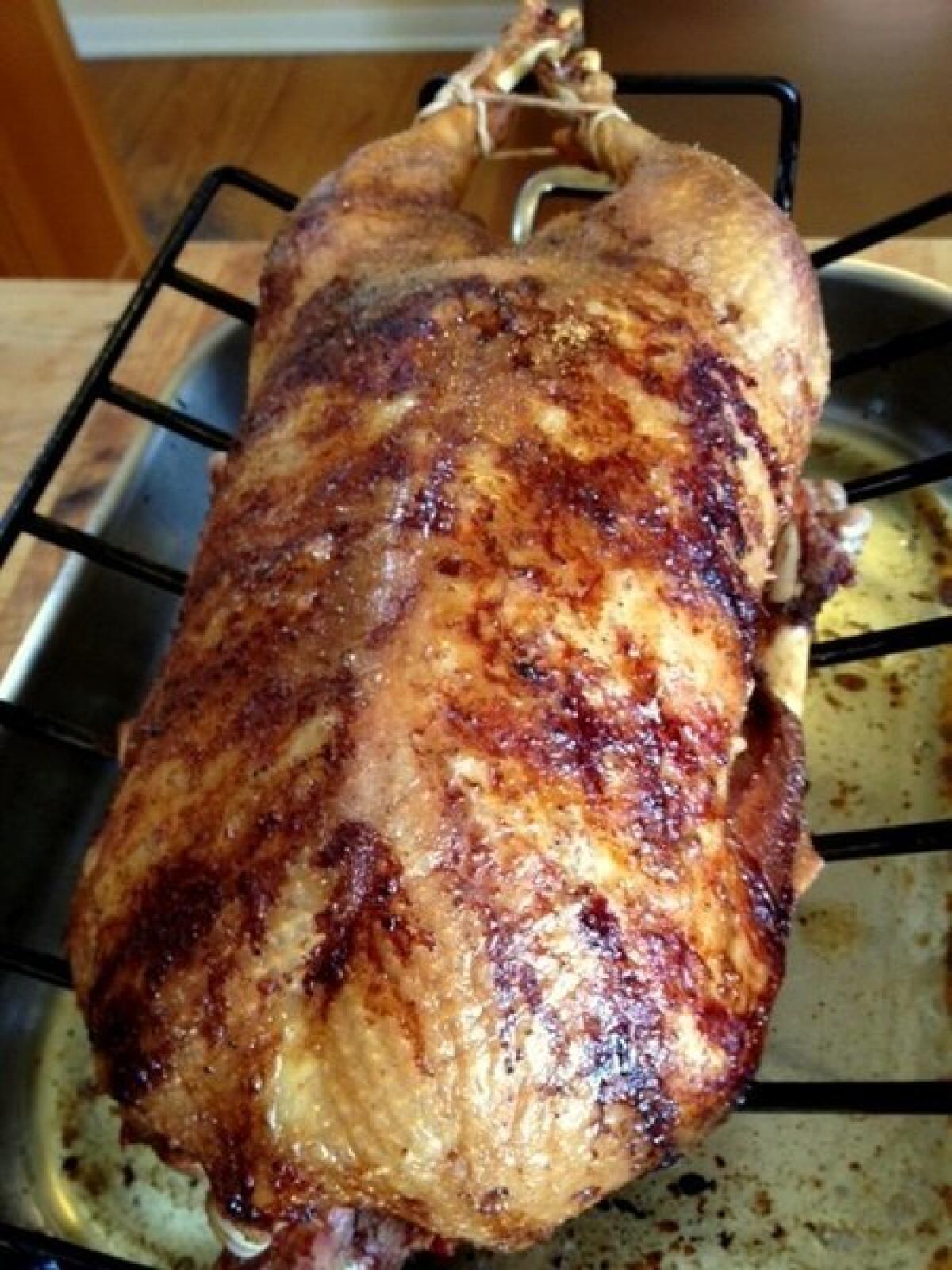The horror! If you’re making goose, avoid ‘non-eviscerated’ or be ready with a sharp knife

- Share via
Well, that was interesting.
It was time to get started testing recipes for an upcoming holiday column on roasting geese, so I picked up a bird from the freezer section at my local 99 Ranch market.
After a slow defrost, I unwrapped it this morning to start cooking. And that’s when I noticed the label: “Confucius Style Young Goose” it said in big print and then, in very small lettering, “Non-Eviscerated Poultry.”
OK. Well, how non-eviscerated could it be? Very non-eviscerated as it turned out. As in, they basically just plucked the goose and packed it in a bag, innards and all intact.
Cleaning it was, you could say, a very visceral experience. I’ve certainly done my share of cutting up Chinatown ducks -- heads and feet are no big deal.
Of course, a goose being a duck writ large, it took a bit more force than usual. Cut around the joint, then bend it back and give it a good twist to dislocate it. The sound effects were grisly, a loud, animal grinding and pop. It sounded like something from “Saw IV.”
My wife, who was on the phone in the next room, went silent for a moment, then came into the kitchen. “What in the hell was that?” She took one look and backed out quickly.
Getting rid of the extra appendages was the least of my worries, though. Because I still had a very intact carcass to deal with.
Funny thing -- I’d never really thought about where the “cavity” of a bird was until I had to open one up myself. My method was decidedly low-tech. I poked and prodded where it seemed like the cavity should be until I found a nice soft spot. I took my chef’s knife and poked through, slicing down to open a slit.
The first thing I saw was a large mass of very soft, almost liquid white fat. I pulled that out with my fingers. There were a couple of larger, firmer blobs as well, and I removed those, too. Goose fat has an altogether different feel than chicken or even duck -- it’s downright oily and it coats your hands like a thick lotion.
Funny thing -- there doesn’t seem to be much on the Internet about home evisceration. I Googled “eviscerate goose” and found only one site on cleaning, plucking and eviscerating chickens (with a “Graphic!” warning that was definitely earned. Did you know there is a special tool for scraping lungs?)
There was nothing for me to do but wing it. So I stuck my hand in the just-opened cavity, keeping as close to the rib cage as possible. I grabbed as much viscera as I could and tugged. It gave a little, but not a lot. I gave it a twist and away it came, with a ripping sound.
I had a hand full of heart, chunky fat and other pieces I couldn’t recognize. But I could tell there was still more in there, so I grabbed once more. This one took more of a pull, and it included the liver, which was not nearly so fatty as I had hoped.
I’d probably spoiled it anyway because in my clumsy rookie eviscerator way, when I tore loose the liver, I also broke the bile duct, which stained part of the liver blackish-green. You don’t need a website to tell you that stuff is nasty.
After a couple of rinses to make sure I’d gotten everything, I patted the bird dry. The only thing left was removing the pope’s nose (technically the “pygostyle” -- the fatty part of the tail, and the oil glands on either side of it, which will contribute a bitter flavor.)
Roasting was another story. Let’s just say that one 12-pound goose gave up more than 3 cups of fat. But you’ll have to wait to read about that.
ALSO:
RECIPES: 13 ways to use a walnut
Korean BBQ great Park’s opens a fast food outlet
RECIPES: Plenty of choices for meatless Monday
More to Read
Eat your way across L.A.
Get our weekly Tasting Notes newsletter for reviews, news and more.
You may occasionally receive promotional content from the Los Angeles Times.











